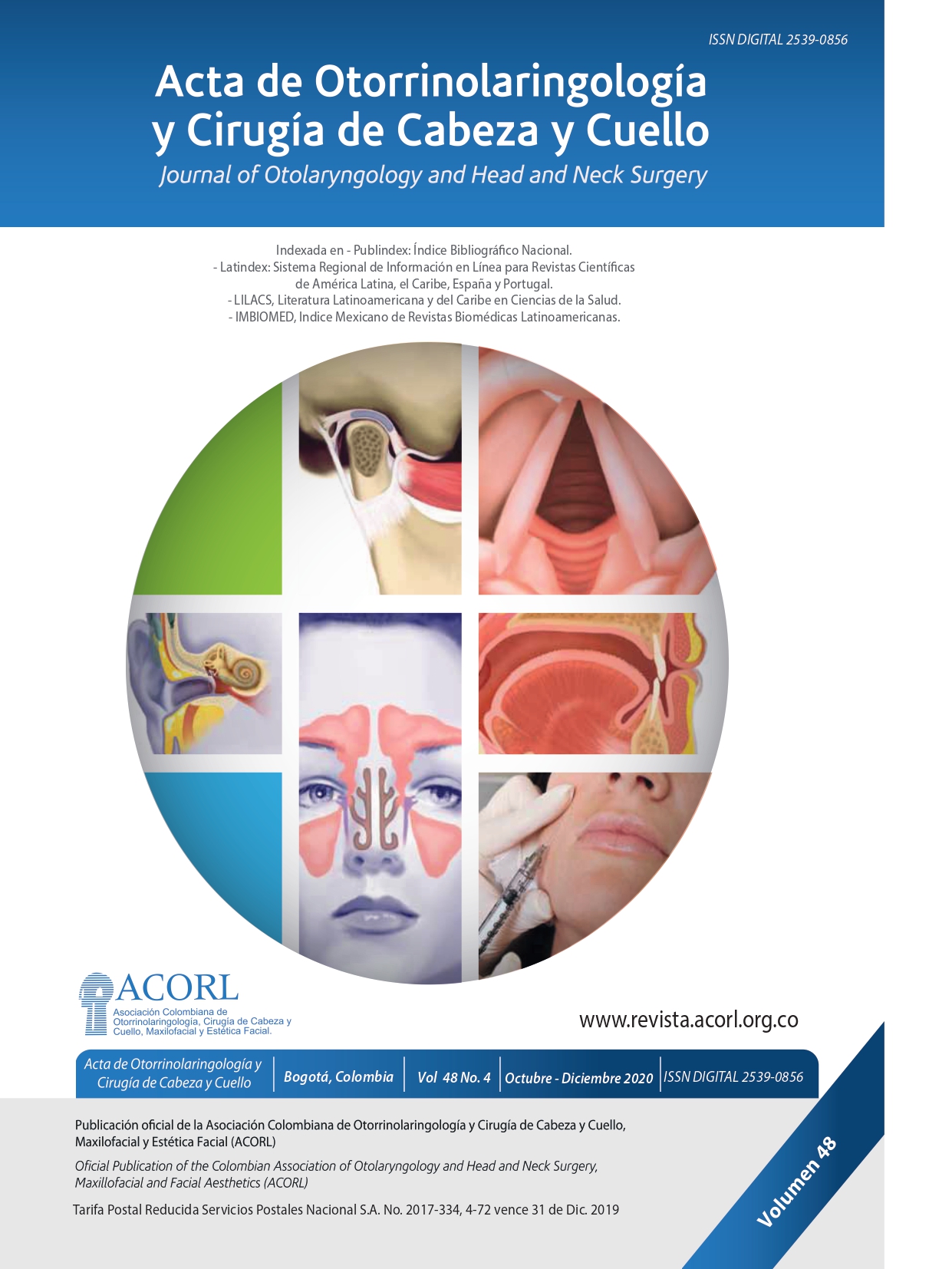Alteraciones en el olfato y el gusto asociadas con la infección por SARS-CoV-2: una revisión
Contenido principal del artículo
Resumen
de vida y el desempeño de algunas labores de la vida diaria, ya que desempeñan un papel fundamental tanto en la rutina como en las relaciones interpersonales. Existen múltiples patologías que alteran estos sentidos, entre estas las enfermedades por infección viral. A través de los últimos meses, se ha demostrado que el virus responsable de la pandemia actual (SARS-CoV-2) puede generar cambios en el olfato y en el gusto secundarios a la infección por este, siendo estas alteraciones, en ocasiones, las primeras manifestaciones. En esta revisión se busca recopilar la información encontrada en la literatura médica y resaltar la importancia de tener en cuenta estas alteraciones al momento de examinar a un paciente y generar una alerta en cuanto a las posibles medidas de aislamiento y/o tratamiento de estos pacientes.
Detalles del artículo
Sección

Esta obra está bajo una licencia internacional Creative Commons Atribución-CompartirIgual 4.0.
Este artículo es publicado por la Revista Acta de Otorrinolaringología & Cirugía de Cabeza y Cuello.
Este es un artículo de acceso abierto, distribuido bajo los términos de la LicenciaCreativeCommons Atribución-CompartirIgual 4.0 Internacional.( http://creativecommons.org/licenses/by-sa/4.0/), que permite el uso no comercial, distribución y reproducción en cualquier medio, siempre que la obra original sea debidamente citada.
eISSN: 2539-0856
ISSN: 0120-8411
Cómo citar
Referencias
Guan W, Ni Z, Hu Y, et al. Clinical characteristics of coronavirus disease 2019 in China. N Engl J Med. 2020;382(18):1708–20.
Villalba NL, Maouche Y, Ortiz MBA, et al. Anosmia and Dysgeusia in the Absence of Other Respiratory Diseases:
Should COVID-19 Infection Be Considered? Eur J case reports Intern Med. 2020;7(4):001641.
Park SE. Epidemiology, virology, and clinical features of severe acute respiratory syndrome coronavirus 2 (SARS-CoV-2; coronavirus disease-19). Pediatr Infect Vaccine. 2020;27(1):1–10.
Zhou F, Yu T, Du R, Fan G, Liu Y, Liu Z, et al. Clinical course and risk factors for mortality of adult inpatients with COVID-19 in Wuhan, China: a retrospective cohort study. Lancet [Internet]. 2020;395(10229):1054–62. Available from: http://dx.doi.org/10.1016/S0140-6736(20)30566-3
Allis TJ, Leopold DA. Smell and Taste Disorders. Facial Plast Surg Clin North Am [Internet]. 2012;20(1):93–111. Available from: http://dx.doi.org/10.1016/j.fsc.2011.10.011
Miwa T, Ikeda K, Ishibashi T, Kobayashi M, Kondo K, Matsuwaki Y, et al. Clinical practice guidelines for the management of olfactory dysfunction — Secondary publication. Auris Nasus Larynx [Internet]. 2019;46(5):653–62. Available from: https://doi.org/10.1016/j.anl.2019.04.002
Imamura F, Hasegawa-Ishii S. Environmental toxicants-induced immune responses in the olfactory mucosa. Front Immunol. 2016;7(NOV):1–7.
Lop Gros J, Iglesias Coma M, González Farré M, Serra Pujadas C. Olfactory dysfunction in COVID-19, a review of the evidence and implications for pandemic management. Acta Otorrinolaringol Esp [Internet]. 2020;(xx). Available from: https://doi.org/10.1016/j.otorri.2020.04.003
Yan CH, Faraji F, Prajapati DP, Ostrander BT, DeConde AS. Self-reported olfactory loss associates with outpatient clinical course in COVID-19. Int Forum Allergy Rhinol. 2020;10(7):821–31.
Meng X, Deng Y, Dai Z, Meng Z. COVID-19 and anosmia: A review based on up-to-date knowledge. Am J Otolaryngol - Head Neck Med Surg [Internet]. 2020;41(5):102581. Available from: https://doi.org/10.1016/j.amjoto.2020.102581
Bénézit F, Le Turnier P, Declerck C, Paillé C, Revest M, Dubée V, et al. Utility of hyposmia and hypogeusia for the diagnosis of COVID-19. Lancet Infect Dis. 2020;3099(20):19–20.
Moein ST, Hashemian SMR, Mansourafshar B, Khorram-Tousi A, Tabarsi P, Doty RL. Smell dysfunction: a biomarker for COVID-19. Int Forum Allergy Rhinol. 2020;10(8):944–50.
Xydakis MS, Dehgani-Mobaraki P, Holbrook EH, Geisthoff UW, Bauer C, Hautefort C, et al. Smell and taste dysfunction in patients with COVID-19. Lancet Infect Dis. 2020;3099(20):30293.
Karimi-Galougahi M, Raad N, Mikaniki N. Anosmia and the Need for COVID-19 Screening during the Pandemic. Otolaryngol neck Surg. 2020;
Karimi-Galougahi M, Yousefi-Koma A, Bakhshayeshkaram M, Raad N, Haseli S. 18FDG PET/CT Scan Reveals Hypoactive Orbitofrontal Cortex in Anosmia of COVID-19. Acad Radiol. 2020;1–2.
Lee Y, Min P, Lee S, Kim SW. Prevalence and Duration of Acute Loss of Smell or Taste in COVID-19 Patients. J Korean Med Sci. 2020;35(18):e174.
Giacomelli A, Pezzati L, Conti F, Bernacchia D, Siano M, Oreni L, et al. Self-reported olfactory and taste disorders in SARS-CoV-2 patients: a cross-sectional study. Clin Infect Dis. 2020;2–3.
Wee LE, Chan YFZ, Teo NWY, Cherng BPZ, Thien SY, Wong HM, et al. The role of self-reported olfactory and gustatory dysfunction as a screening criterion for suspected COVID-19. Eur Arch Oto-Rhino-Laryngology. 2020;(0123456789):20–1.
Lechien JR, Chiesa-Estomba CM, De Siati DR, Horoi M, Le Bon SD, Rodriguez A, et al. Olfactory and gustatory dysfunctions as a clinical presentation of mild-to-moderate forms of the coronavirus disease (COVID-19): a multicenter European study. Eur Arch Oto-Rhino-Laryngology [Internet]. 2020;277(8):2251–61. Available from: https://doi.org/10.1007/s00405-020-05965-1
Beltrán-Corbellini, Chico-García JL, Martínez-Poles J, Rodríguez-Jorge F, Natera-Villalba E, Gómez-Corral J, et al. Acute-onset smell and taste disorders in the context of COVID-19: a pilot multicentre polymerase chain reaction based case–control study. Eur J Neurol. 2020;27(9):1738–41.
Eliezer M, Hautefort C, Hamel A-L, Verillaud B, Herman P, Eloit C. Sudden and Complete Olfactory Loss Function as a Possible Symptom ofCOVID-19. JAMA Otolaryngol - Head Neck Surg. 2020;92(6):E1–2.
Karimi-Galougahi M, Yousefi-Koma A, Bakhshayeshkaram M, Raad N, Haseli S. 18FDG PET/CT Scan Reveals Hypoactive Orbitofrontal Cortex in Anosmia of COVID-19. Acad Radiol. 2020;27(7):1042–3.
Kaye R, Chang CWD, Kazahaya K, Brereton J, Denneny JC. COVID-19 Anosmia Reporting Tool: Initial Findings. Otolaryngol - Head Neck Surg (United States). 2020;163(1):132–4.
Hopkins C, Kumar N. Loss of sense of smell as marker of COVID-19 infection: joint statement from the British Rhinological Society and ENT-UK. Entuk. 2020;1–2.
Doty RL. Treatments for smell and taste disorders: A critical review. Handb Clin Neurol. 2019;164:455–79.





